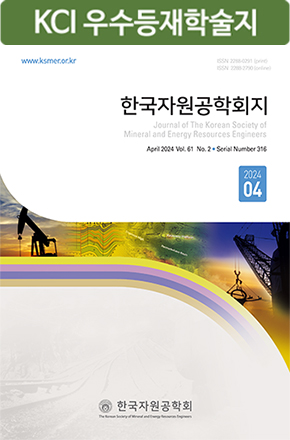Research Paper
- Aadnoy, B. and Chenevert, M., 1987, “Stability of Highly Inclined Boreholes (includes associated papers 18596 and 18736),” SPE Drilling Engineering, Vol. 2, No. 4, pp. 364-374.
- Amadei, B., 1982, The influence of rock anisotropy on measurement of stresses in situ, Ph.D. Thesis, University of California Berkeley, USA.
- Amadei, B., 1996, “Importance of Anisotropy When Estimating and Measuring In Situ Stresses in Rock,” International Journal of Rock Mechanics and Mining Sciences and Geomechanics Abstracts, Vol. 33, No. 3, pp. 293-325.
- Chang, C., Lee, J.B. and Kang, T.S., 2010, “Interaction between regional stress state and faults: Complementary analysis of borehole in situ stress and earthquake focal mechanism in southeastern Korea,” Tectonophysics, Vol. 485, No. 1, pp. 164-177.
- Cho, J.W., Kim, H., Jeon, S. and Min, K.B., 2012, “Deformation and strength anisotropy of Asan gneiss, Boryeong shale, and Yeoncheon schist,” International Journal of Rock Mechanics and Mining Sciences, Vol. 50, pp. 158-169.
- COMSOL Inc., 2010, COMSOL multiphysics user’s guide, Stockholm, Sweden.
- Fjær, E., Holt, R.M., Horsrud, P, Raaen, A.M. and Risnes, R., 2008, Petroleum related rock mechanics, 2nd Ed., Elsevier, Amsterdam, The Netherlands.
- Gaede, O., Karpfinger, F., Jocker, J. and Prioul, R., 2012, “Comparison between analytical and 3D finite element solutions for borehole stresses in anisotropic elastic rock,” International journal of rock mechanics and mining sciences, Vol. 51, pp. 53-63.
- Kim, H., 2012, Anisotropy of elastic moduli, P-wave velocities, and thermal conductivities of transversely isotropic rock and its borehole stability, Master’s thesis, Seoul National University, Korea.
- Lee, H., Ong, S.H., Azeemuddin, M. and Goodman, H., 2012, “A wellbore stability model for formations with anisotropic rock strengths,” Journal of Petroleum Science and Engineering, Vol. 96, pp. 109-119.
- Lee, Y.K. and Choi, B.H., 2011, “Anisotropic version of mohr-coulomb failure criterion for transversely isotropic rock.” Journal of Korean Society for Rock Mechanics, Vol. 21, No. 3, pp. 174-180.
- Lekhnitskii, S.G., 1963, Theory of elasticity of an anisotropic elastic body, Holden-Day, California, USA.
- McLamore, R. and Gray, K., 1967, “The mechanical behavior of anisotropic sedimentary rocks,” Journal of Engineering for Industry, Vol. 89, pp. 62-73.
- Okland, D. and Cook, J., 1998, “Bedding-related borehole instability in high-angle wells,” SPE/ISRM Rock Mechanics in Petroleum Engineering, Society of Petroleum Engineers, TrondHeim, Norway, July 8-10, pp. 413-422.
- Ong, S.H., 1994, Borehole stability, Ph.D.Thesis, The University of Oklahoma, USA.
- Park S.C. and Moon H.K, 2014, “Stress-path and Stress-mode Analyses of a Circular-shaped Shaft Excavated in Various In-situ Rock Stress States,” Journal of Korean Society of Mineral and Energy Resources Engineers, Vol. 51, No. 6, pp. 794-807.
- Peška, P. and Zoback, M.D., 1995, “Compressive and tensile failure of inclined well bores and determination of in situ stress and rock strength,” Journal of Geophysical Research: Solid Earth, Vol. 100, No. B7, pp. 12791-12811.
- Pietruszczak, S. and Mroz, Z., 2001, “On failure criteria for anisotropic cohesive-frictional materials,” International journal for numerical and analytical methods in geomechanics, Vol. 25, pp. 509-524.
- Yoon, J.P., Kim, H.T. and Park, H.W., 2013, “A Stability Analysis of Directional Drilling on the Shales with Weak Bedding Planes,” Journal of Korean Society of Mineral and Energy Resources Engineers, Vol. 50, No. 3, pp. 329-338.
- Zoback, M.D., Moos, D., Mastin, L. and Anderson, R.N., 1985, “Well bore breakouts and in situ stress,” Journal of Geophysical Research: Solid Earth, Vol. 90, No. B7, pp. 5523-5530.
- Zoback, M.D., Barton, C., Brudy, M., Castillo, C., Finkbeiner, T., Grollimund, B., Moos, D., Peska, P., Ward, C. and Wiprut, D., 2003, “Determination of stress orientation and magnitude in deep wells,” International Journal of Rock Mechanics and Mining Sciences, Vol. 40, No. 7, pp. 1049-1076.
- Zoback, M.D., 2007, Reservoir geomechanics, Cambridge University Press, Cambridge, UK.
- Publisher :The Korean Society of Mineral and Energy Resources Engineers
- Publisher(Ko) :한국자원공학회
- Journal Title :Journal of the Korean Society of Mineral and Energy Resources Engineers
- Journal Title(Ko) :한국자원공학회지
- Volume : 52
- No :4
- Pages :401-413
- DOI :https://doi.org/10.12972/ksmer.2015.52.4.401


 Journal of the Korean Society of Mineral and Energy Resources Engineers
Journal of the Korean Society of Mineral and Energy Resources Engineers







